Today reader Vana2 whose name is Hank, tells us about the uses of different paper targets.
If you’d like to write a guest post for this blog, please email me at blogger@blogger.com.
Take it away, Hank
What sort of targets do you shoot?
by Hank, Vana2
This report covers:
- Target selection
- The classic archery target
- The competition target
- 100-yard sighting target
- Specialty targets
- My tuning target
- Report Card target
- Summary
Target Selection
Instead of asking what sort of targets do you shoot at, a better question might be why did you choose that target format.
A quick Google on “Target” will show hundreds of different formats for every imaginable use. But even with all the targets available for sale or download, I still design my own custom targets tweaked to my needs. So now you are asking me WHY?
Why?
The why is because each target type is designed for a specific application and use. I’d like to discuss some typical targets before I get to the specific one that I want to show you.
The classic archery target
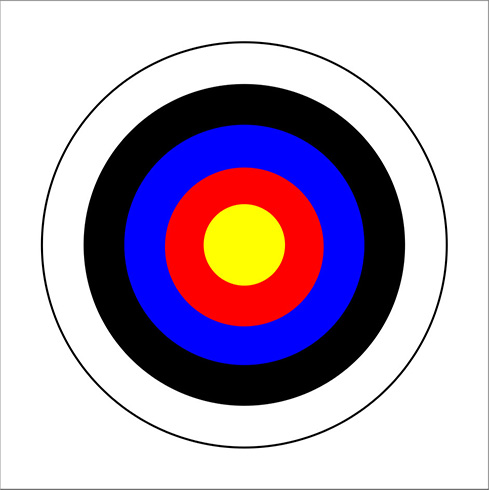
An archery target.
An archery target can be a couple of feet in diameter, the yellow is the target, the rest is for reference.
If you ask the average person to describe a target they will inevitably describe the multi-color concentric band archery target. This seemingly simple target is actually carefully designed to be visible at long distance, and to aid in drawing attention from the large target face to the aim point. Even the traditional colors – white, black, blue, red and yellow, are selected to help with focus.
Concentric bands of color can be a visually powerful tool. The artist Claude Tousignant did some interesting studies using alternating values of complementary colors in innovative ways in his circle/target paintings.
The competition target
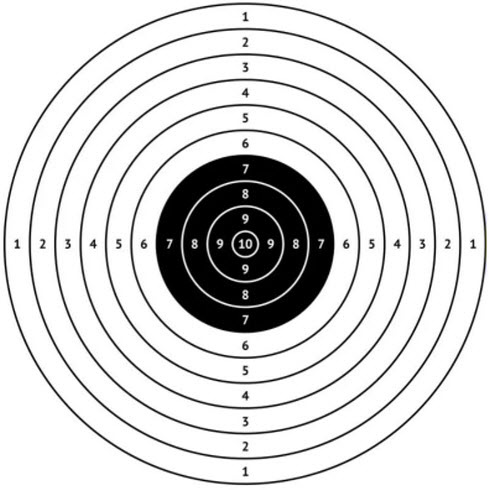
This is a typical concentric ring competition target.
The competition target is the next most popular. It consists of concentric rings with scoring values and a black area as the visual aiming point.
The scale of the target, the size of the aiming point and the number of targets on the sheet vary with the type of competition. The size of the aim point is depends on the sights being used (iron sights, aperture or scopes) and the range at which that the competition takes place. Sometimes multiple shots are taken per target. Sometimes there are multiple targets with only one shot taken per target.
These targets are meant to be scored to determine the winner of a competition or keep stats to see how well we are doing that particular day.
By ignoring the scoring ring, the competition targets can also be used as simple aim points for shooting groups.
100-yard sighting target
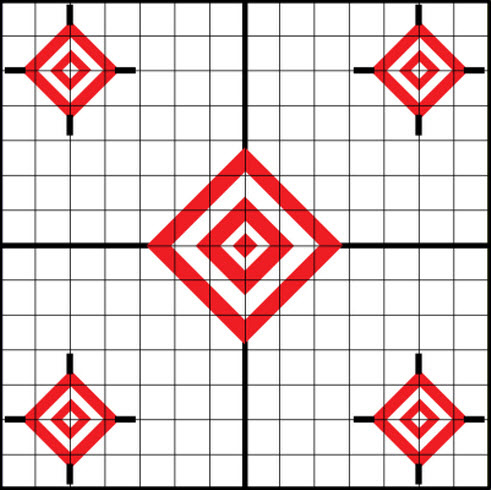
A typical sighting target features a couple of aim points, scope reticule alignment bars, and a coarse grid.
Hunters and people who shoot at longer ranges use a sighting target with a predominant aim point that is designed facilitate scope alignment and a grid (usually one inch spacing) to assist on making adjustments.
The scope might be zeroed to the aim point or just referenced to it using the grid. For example, if a suitable range is not available, adjusting to hit 2 inches high at 100 yards could mean on target at 250 yards. Of course that depends on many things like velocity, ballistic coefficient, etc.
Specialty Targets
There are target designs to check specific things. An example would be a “Tall Target” which consists of a vertical line on a tall (3 or 4 foot) backing board with an aim point at the bottom. The rifle is zeroed on the aim point and the turret is adjusted up some distance and more shots are fired.
The distance between the first and the second group is measured and the empirical data is compared to the theoretical offset from the turret to determine if the turret is tracking accurately or is a bias factor is required to be applied in the ballistic calculator.
Sometimes, a simple mark or dot on a backing board as an aim point is all that is required to determine if the zero is still true or what “Kentucky Windage” is required for a particular distance.
My tuning target
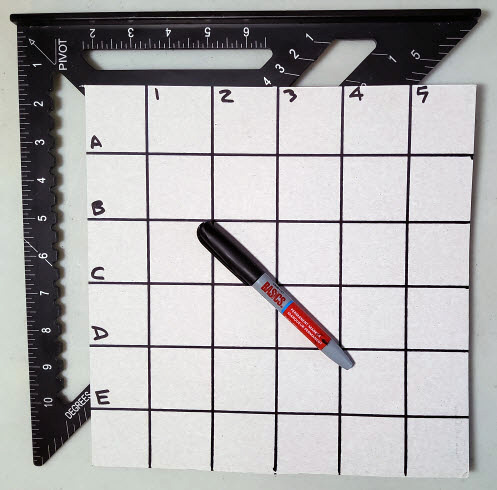
My tuning target is a 5 by 5 grid on cardboard that takes under a minute to draw using a Rafter Square.
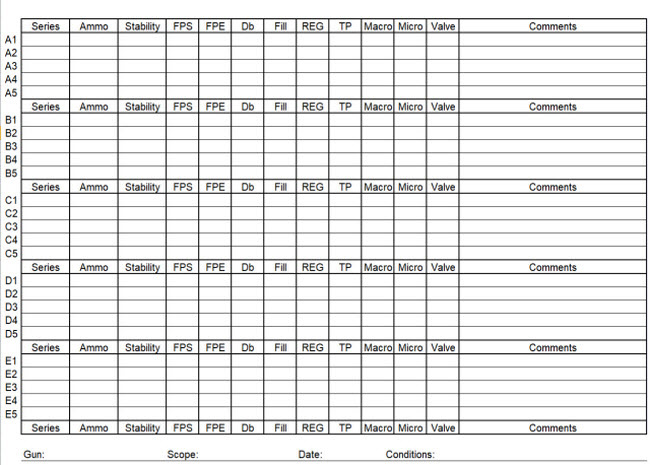
This is the Notes Sheet that ties all the session information together.
Then there are approaches that can be very helpful. Late last fall a friend asked to use my range to tune his airgun. The range was free so no problem and I left him to do his thing.
After several hours of frustration (and a couple of tins of 20-cent .30 caliber pellets) he asked for help. He had hundreds of holes in targets and couldn’t relate the groups to the settings to the stats. I gave him the grid target I use for testing pellets and tuning PCPs. Then I introduced him to my Notes Sheet and explained how to use it.
The notes sheet references the grid intersections of the Tuning target (labeled A1, A2 etc.) so that all the details can be tracked. I use the grid intersections as needed depending on how/what I’m doing. Usually I’ll shoot 5 per grid, sometimes I’ll abandon the grid if it’s not going well, sometimes I’ll shoot a dozen or more shots just to see what develops.
My notes sheet is suitable for all of the things that I track for different airguns so what is filled in is dependent on the particular rifle. The thing is that all the data is captured in a consistent format.
Most of the fields are self-explanatory so I will be brief in describing them. The A1 to A5, B1 to B5 etc. are the grid references. SERIES refers to the shot strings on my LabRadar, I frequently refer to the velocity data when tuning. You can record the velocity information on paper if you have another type of chronograph.
AMMO is obvious. STABILITY is what I see from the pellet and the point of impact. I note the magnification of the scope and reference the sub-tends to get a number to describe how poorly a pellet might be spiraling.
FPS and FPE are average data points for the group. dB is the maximum decibel level for the group and helps me when fine tuning for efficiency (excessively noisy PCPs are wasting air). FILL and REG monitors the current settings and air usage. TP, MACRO, MICRO, and VALVE are all the adjustments I have available. COMMENTS are always useful when trying to remember what you were thinking about at the time. Your needs and notes may be different.
A career of working in an engineering environment has taught me that keeping detailed notes can be a cover your a$$ (CYA) life saver when someone asks, What happened and why?
Report Card target
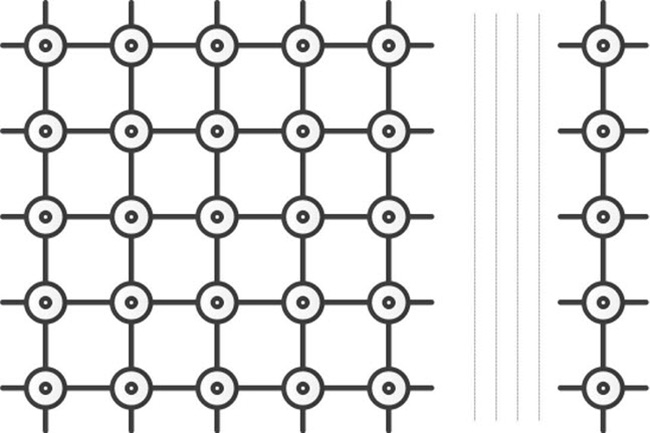
Report Card target.
A report card is useful when monitoring performance of the equipment and the shooter. If you are competing there are the targets mentioned above for that but often I want to keep track of how well the airgun, ammo and shooter (mostly the shooter) are doing. For that I shoot a report card. I shoot five groups of 5 and 25 single targets (a 5×5 array) to give me 50 shots on one target face to evaluate.
The groups are measured in the conventional way (center-to-center); the group sizes are added and averaged to give me a number for reference that I call AG (average group).
I measure the single targets from the POA (point of aim) center to of the POI (point of impact), total up the row values and average them. Then I average all the rows to give me a number (AR – average radius) that represents the distance that I’m “off the mark”. Just for giggles, I’ll double the radius for the AD (average diameter) number that, theoretically, should be similar to my average group size.
All this good stuff is recorded on the report card and a digital copy is filed for the airgun.
Shooting a card gives me a decent sample size (50 shots) and presents all of the impacts on one target face so that I can see what is happening. Is the airgun shooting consistently? Are there lots of fliers? How is my trigger control, focus and follow through? Am I canting the rifle (again)?
The card gives me a good idea of the performance I can get from that airgun, at that distance with those pellets. It’s nice to see an improvement, its also good to know if you’re slipping.
Summary
So there’s lots of target option available and any decent aim point is usable. Sometimes having something specific to your needs can be a big help.
Be safe, shoot straight!
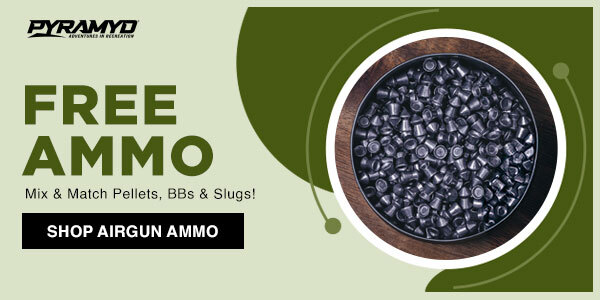
Hank,
That is a very systematic method of recording the data. Thank you very much for this article.
Siraniko
Oh my . . . once I got down to the tuning target I was one lost Kentucky boy. Hey, Kentucky windage I got, the rest makes me glad to be a springer guy. I spent the afternoon today out at the range just having fun. I use a variation on the Report Card target (got a C+ today) Yep . . just having fun. Got it guys, just having fun. Orv.
Hank
Impressive! I’m speculating that Shootski is either equally impressed or is doing the same thing you are.
In simple ways I share some likes with you. I make my own targets using various stencils on interior walls of cereal boxes. All my paper targets eventually go in a recycle bin. I draw at least one 1 inch line on every target so I have some idea of group sizes when using scopes with different magnification. The “military” test (5 shots each at 5 bullseyes) is the best sampling for measuring group size performance in my opinion. Shooting more than 25 shots tires me and invites too much shooter variation. Having said that, I mostly shoot 10 shots at one target because I have way too many guns that demand keeping seals happy. Sometimes I’ll shoot 5 or more airguns in one day always in rotation in whatever order; PCP’s, single strokes, pumpers, springers and CO2’s (except in winter). I find myself enjoying the not so accurate as much as the one holers. Each gun has its own standard.
A bit off topic but I recently have found a new 20 yard corridor that is well protected from wind. The improvement in group sizes for my FWB300C is significant. A post on variation caused by wind a while back got my attention.
Thanks for this good report.
Deck
My Feinwerkbau above should read S not C.
Another thing we share is record keeping. I have kept Google doc diaries on shooting and golf since I retired 25 years ago. For shooting I keep range, wind speed, temperature, airgun, pellet, hold and group size. The format I use easily draws my attention to the airgun used which is helpful when looking up old data.
Here is a sampling of a few days. It doesn’t show the Google doc bullet point format I use and I can’t post photos but you get the general idea.
2/21/25. At 20 yds, 42*, 2 mph
HW50S, FTT, peep, bag near T/g, scored .59”
1377, Bar FT, 3 pps, vert string, scored 2.01”
Blue Streak, H&N, scored .2.01”, 8 did .82”
Daisy No. 25, shot 25 at pine cones
Daisy 499 B, shot abt 12 times at pine cones
2/22/25. At 33 yds, 5 mph, 52*
Hatsun 95, JSB10.3, bal, scored 1.51”, 8 did .92”
ATAC, FTT, on bag, scored 1.59”, 8 did .72”
ASP20, JSB8.4, on bag, scored .64”
Urban, AA16, scored .59”
Avenger, JSB25.4, scored .84”, 8 did .63”
2/27/25. At 20 yds, 10-12 mph, 70*
Hatsun95, JSB10.3, carbine hold mid fgr pull, scored .20”
Dragon, AA16, 3 pps, scored .59”
Dragon, AA16, 7 pps, scored .57”
2/28/25. At 20 yds, 7-8 mph, 63*
Avanti 753, Falcon, scored .64”
Impact, JTS, 22 art hold, scored .84”
Titan, AA16, 22 art hold, scored .72”
Yukon, FTT, 22 art hold, scored .40”
Note: Yukon is now serious accurate.
PS: Starting today I have to log in every time. IT has done something. It requires this for both my IPad and Android cell phone.
Deck
Decksniper,
” I’m speculating that Shootski is either equally impressed or is doing the same thing you are.”
IF i am correct I’m actually feeling guilty for having ENABLED Hank down this rabbit hole! Although Hank claims: ” I’m still primarily a casual plinker at heart but have to admit that tuning and bench shooting has added a whole new dimension to airguns.” In on blog and off blog discussions (about precision, accuracy and tuning for them) with Hank i believe i am guilty; perhaps he will let me off the hook by saying it was inevitable…but i doubt it.
I’m also impressed by Hank’s most excellent Guest Blog. Yes i have used many of his techniques and some of the same targets to D.O.P.E. (Data On Previous Engagement{s}) my shooting for each device. I have been shooting for almost seven decades and have internalized many of the factors involved in both terrestrial and airborne shooting. I use baseline D.O.P.E. to check the function of my devices against current and recent Engagements. Although Hank’s Note Sheet is a great baseline record it would need to capture all the Ballistically and Mechanically significant data points to be actually considered D.O.P.E by a professional.
For hunting i use a very simple target hung in the woods for stalking type hunting the one attached is thirty shots from various distance and different points off hand, kneeling, and prone with my .22 Cal. ASP20.
shootski
Shootski,
Yeah, it was inevitable that I fell down this rabbit hole.
I didn’t need too much of a push from you, thanks for your help anyway 😉
Hank
I normally just download from a free download site.
https://www.gr8fun.net/index.php?main_page=page&id=4
They have several different variations, my favorite is a 5 x 10m target using a color laser printer.
There is a scale on the target so you can scale the printing to get the correct dimensions, if you desire.
It is quick easy and inexpensive. I use it from 10m to as far as 25 yards, which is the maximum easy distance in my back yard.
Mike
This is FM’s go-to site for free downloadable targets, including ones suitable for those days when FM is in the mood to be a “politically incorrect” bad boy at the home range.
https://targets4free.com/
Hank,
Superb. This is one very good explanation for the use of different targets.
Most of the time, being famous (infamous) for being of Scottish descent and very frugal (cheap), most of my targets are usually handmade. I also do not keep extensive records of the performance of my airguns. This may be due in part to my lack of a formal engineering education. Also, Mrs. RR complains I have enough clutter as it is.
Most of the time I am shooting an airgun to do a report on. During those particular sessions it is often my desire to only show the size of the group to the poor souls who have elected to be my audience. Being frugal (cheap) I most often make my targets of materials that are readily available, such as cardboard. It is not the ideal target material for illustration purposes, but it generally serves the purpose for illustrating how a particular airgun does in my hands. I should make note here that I do not consider myself that great of a shot anymore and I typically do not spend much time with many of these airguns and learn their particular nuances as I should.
As for targets, over the years I have settled on three particular types. For scopes I will use an X drawn with a Sharpie on the cardboard as my sight point. My POA is where the two lines intersect, my theory being “Aim small, miss small.” If I should happen to shoot out the X center, the lines in each quadrant of the scope reticle will point to the aimpoint.
As for open sights, I typically use a price dot as my aimpoint. Again, using a Sharpie I will color it black to make it more visible before I stick it on the cardboard.
Recently I have begun to use official NRA competition air rifle targets for when I shoot open sights as these rather old, tired eyes have a real hard time seeing those tiny price dots these days.
Now, this is for showing you folks how well (or poorly) I am shooting a particular airgun that I happen to be telling you folks about. When I am shooting for me with my airguns, I often shoot feral soda cans with my open sighted sproingers as I am just doing it for fun and I have geegobs of them.
When I am shooting my scoped PCPs, after I have zeroed them using the drawn X, I often shoot at my spinners. They vary in size from two inches down to 1/4 inch. At closer ranges I will sometimes use my spinners for open sighted airguns also. The spinners provide me with immediate feedback. I typically start with the larger spinners and work my way down in size. When I miss, I will back up one size and work my way downward again.
Now that I have thoroughly bored you, go out and shoot some.
“Aim small miss small” RR you bet.
When taking out the LGV for a walk in the backyard I usually take a shot at a cardboard and then use that first hole as my sight point.
By the way there is a new wannabe rival to the LGV. I exchanged my AEA semi auto for cash and a gen2 Prosport in 5.5. I thought it was appropriate that you should learn about it first. One mattelomatic for a Classic plus 500$ sounded like a good deal.
Bill,
I have a BSA R10 SE dressed in a beautiful walnut stock I have yet to shoot. It will not be long now though. It is in the case at the foot of the bed. It just might see some range time tomorrow.
Bill,
The AA Prosport is indeed one to covet. Most of the AA line of sproingers are to be coveted by all, most especially if they are dressed in walnut.
RR
Despite the trader’s opinion that the one I got is walnut it doesn’t seem like it. Yes I looked at Tom’s 7 parts review where he said that not every walnut stock looks gorgeous but I still have doubts. Not that I care much about it since just holding and looking at it makes me happy. I think it just needs some detuning for calm and ease of use. Going down to 12 fpe from the 15+ seems to be the way.
Bill,
The “old gals” I have around here all have walnut stocks. It is not so much the pattern of the grains that tell you such, but the darkness and hardness of the wood. As it ages, it will become even darker. It is also a heavier wood. Perhaps the best way to tell is to see if the “inner recesses” have been stained dark.
Does it really matter? Not usually. Being an Air Arms, the performance level of such is what really counts. I personally like the lower performance levels on sproingers. I do think those UK folk just may know what they are talking about concerning power levels and sproingers, even if some of them may have forgotten the whys and wherefores. I would most definitely hang onto the “high power” components though, just in case you change your mind.
RR
I will follow your advice regarding power, maybe with some heavier grease (TIAT etc). As it is the shot cycle and the mechanics are one step behind the 12 fpe German’s LGV. Obviously you already enabled me to take the stock out in order to check the inner recesses. The wood looks quite dark but then again is 20+ years old. We will see. If only I could afford a laminate stock…
Anyway thanks for your response and advice.
Bill,
I am not against laminates as I would rather have them than beech or other light woods, but being such an old, fat, bald headed geezer, I am just a little bit set in my ways. Having said that, even if it is not walnut, it sounds like you got a pretty good deal.
Gamo targets are incredibly inexpensive, made of ‘cardboard’, and show holes for even slow pellets. They’re not standard, but are close enough to 10M for practice. The trap is very good, but i just use a standard 22LR trap.
Thanks for your comments, I’ll read more as I have time. I’m kinda busy helping my wife after her lung surgery.
A quick note, things were simple when there was only a FWB 124 springer in the cabinet. Now there’s a dozen PCPs and another dozen SSPs, springers, and muli-pumps so it’s difficult to keep track of all the details without good notes.
I’m still primarily a casual plinker at heart but have to admit that tuning and bench shooting has added a whole new dimension to airguns.
Here’s a sample of the Report Card to show what it looks like in real use. Besides being an excuse to shoot, the Cards are a way to visually keep track of things.
Cheers!
Hank
Hope the Mrs. recovers quickly and well; all surgeries stink, even minor ones.
Like that “report card” target, maybe will give that a try sometime, or a variant of it, though at this point FM does not need to get too sophisticated about his targeting “skills.” Hitting the broad side of the proverbial barn is “good enough for government work,” in his case.
Hank,
Wow, hope the wife is doing ok, way back in 1993 I had lung surgery and it was the most painful thing I had ever experienced, at the time I guessed that it would be possible to die from the pain alone. Many years later I am still alive but there are times of pain still.
Hopes and prayers to you and your wife.
Mike
Thanks Hank, this is an interesting and useful report. I plan to incorporate some of your ideas into my situation. Organization has never been one of my strong traits. So, I need ideas like these to inspire better ways of doing things.
Elmer Fudd,
The following may help: https://rockymountainelkfoundation.org/elk-network/why-more-hunters-are-using-d-o-p-e/#:~:text=You've likely heard the,utilize that data when needed.
Even if you don’t hunt or pest!
shootski
Elmer,
A 3-ring binder and some dividers is a good thing to have at the shooting bench. Use a date-code to tie notes to targets.
That worked for me for years, now most stuff ends up in a folder on the computer where it can be found quickly.
Hank
Hank,
Thank you for a very informative article. I’m not quite that organized, when it comes to shooting & keeping track of my targets. I mostly sight in at 25 yards and hold over/under for plinking.
I have seen a target that I find interesting, although it is designed for powder burners it could be reduced for airguns.
https://bulletin.accurateshooter.com/2013/01/45212/
Have fun making ‘little’ groups.
Bill
Vanna2,
Strength and prayers for you both.
BRAVO ZULU for your Guest Blog.
shootski
When sighting in, I just use a large cross. Work the horizontal till you are on the cross. Do the same with the vertical. Magic marker and a large piece of paper is all you need.
-Y
Hank,
Anything that moves or not, like lots of targets such as this; https://www.pyramydair.com/product/national-target-air-rifle-target-12-bullseye-100-ct?a=3539 and this; https://www.pyramydair.com/product/crosman-squirrel-resetting-target?a=5950 and this; https://www.pyramydair.com/product/birchwood-casey-shoot-n-c-6-targets-12-bullseye-targets-48-pasters?a=3119 nice that you can see your hits at a distance. And this; https://www.pyramydair.com/product/allen-ez-aim-triple-spinner-target-system-multicolored?a=14978 and of course the feral cans and bottles that show up.
Thanks for a nice blog on targets.
Mike
Hank,
Thank you for an excellent report!
Yes, these are certainly a set of targets that one might expect to see from someone who had: “A career of working in an engineering environment.” 🙂
They are so good that it makes me feel embarrassed to show the cheesy targets I make for testing air rifles with open sights…yet it is an easy-to-make target that allows me to focus on it quite well. 😉
Cheers!
dave
BB
Off subject. In exploring older reports I came across under history your Harry Pope accuracy record at 200 yards. It emphasized that loading from the muzzle put grooves in the bullet assuring the bullets base was more uniform during ignition than breech loading. My question to you is does a probe inserting a projectile into the chamber far enough to cut grooves in it help accuracy? Your comments about your competition pistols seem to suggest it if I understand it.
I hope I have worded the question correctly. Pope proved the bullet’s base is more important than the bullets front regarding accuracy.
Deck
Decksniper,
An article in: https://www.shootingtimes.com/editorial/harry-m-pope-accurate-rifle-barrels/367671#replay might be of interest; the following is an excerpt from that piece.
“As related by Harvey Donaldson, Harry’s method of loading a breechloader from the muzzle was as follows: First insert a dummy cartridge (with the mouth of the case plugged) into the rifle’s chamber. Then carefully place the bullet into the rifle’s muzzle and push it down until it touches the dummy round. Withdraw the ramrod slowly so as not to suck the bullet part way up the barrel. Replace the dummy cartridge with a loaded one that had a grease wad on top.”
shootski
Deck,
The answer depends on whether the probe loads the pellet straight. If so then yes. If not then no.
BB
BB & Shootski
Seems to me that deep seating a pellet (not slug or bullet) with a pen or short end of an Allen wrench should help to load any pellet straight.
Thanks,
Deck
Decksniper,
All i can say is it depends.
Just as Tom indicates in his answer to your question.
I will add some to the basics that might make our answers a bit clearer.
It depends on the individual barrel and how it was bored along with the alignment of the bolt/probe to the axis of the barrel at the breach. If there is any misalignment(s) the soft Lead and/or the maliability of the pellet (projectile) structure can cause misloading. The tolerances are tiny most of the time but they are still tolerances and that means there is room for enough misalignment to have it cause relatively large variances down range.
I believe that Pope was ONLY after one thing by muzzleloading his breachloadersand that was the reduction of the deformation (to the base) of the projectile behind the Center of Gravity which causes the projectile to wobble outside the barrel and likely never settle into a stable spin; that is instant death to repeatability and also shot POA to POI predictability. There is no way he could find to make certain that those “tails” on the projectile base would be consistent from one to the next other than to eliminate them by loading from the muzzle.
I do wonder if his method eliminated the gas cutting that projectile bases experience during the ride up the barrel. I don’t know and don’t think he ever covered that issue.
shootski
Shootski
Good points all. I’m not sure any of this will have measurable effect on my shooting at 33 yards and less due to other variables. I was just curious about Harry Pope’s incredible score and his loading system. Having been a firearm reloader for years I am well aware of the advantages of shooting single shot when using custom built cartridges. Removing bullet jump and loose brass necks can sometimes help produce smaller groups at long distances. Cartridges loaded this way won’t even go in the magazine or clip. It’s just as well because this avoids having gun powder in your lap.
Deck
I know the record keeping would make me a more consistent and less confused shooter but just reading about record keeping stresses me out.
I shoot to reduce stress and just enjoy myself. I am happy when I hit what I am aiming at and just ignore my misses and reload. If I am missing a lot, I will pull out one of my most consistent shooters just to regain my confidence.
Of course, with my attitude towards shooting, I stink at competition and do not enjoy it.
David Enoch